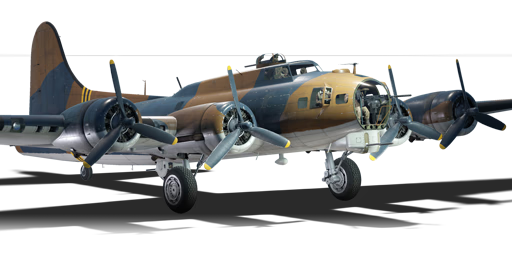



By 1948, B-17s were no longer in service with the USAF as bombers. And since the IAF was desperate to acquire any combat-worthy aircraft, they got their hands on 3 privately owned, unarmed units that were flown to Czechoslovakia and armed with 7.62 mm MGs, makeshift bomb sights and German bomb racks. The planes bombed several targets during their journey to Israel, and during the entire Arab-Israeli War of 1948, the 3 planes flew 200 sorties. After being used as radio transceivers during the Sinai War of 1956, they were finally fully decommissioned in 1958.
The B-17 was introduced along with the initial Israeli air tree in Update "Winged Lions". At its BR, it's vulnerable to almost any plane, but especially those with air spawns or good climb rates. Planes like the Ta 152H, F8F-1B, and Bf 109s are common threats thanks to their good armament and climb capabilities. Like all strategic bombers, the B-17 is capable of destroying an entire base, however once spawned pilots should try to climb to more than 6000 m to be safe at least until the base is destroyed. When facing enemy planes, the weakest position is the front. Thus, when a dangerous enemy plane is detected, pilots should give the rear of the plane to the enemy to make shots harder.
flaps
flaps
flaps
brake
| Belt | Belt filling | Armor penetration (mm) at a distance: | |||||
|---|---|---|---|---|---|---|---|
| 10 m | 100 m | 500 m | 1000 m | 1500 m | 2000 m | ||
| API-T/AP/AP/I | 30 | 27 | 20 | 13 | 9 | 6 | |
| AP/AP/AP/API-T | 30 | 27 | 20 | 13 | 9 | 6 | |
| AP-I/I/AP-I/API-T | 28 | 26 | 18 | 11 | 7 | 4 | |
| Belt | Belt filling | Armor penetration (mm) at a distance: | |||||
|---|---|---|---|---|---|---|---|
| 10 m | 100 m | 500 m | 1000 m | 1500 m | 2000 m | ||
| API-T/AP/AP/I | 30 | 27 | 20 | 13 | 9 | 6 | |
| AP/AP/AP/API-T | 30 | 27 | 20 | 13 | 9 | 6 | |
| AP-I/I/AP-I/API-T | 28 | 26 | 18 | 11 | 7 | 4 | |












Flight performance | |
|---|---|
Survivability |
|---|
Weaponry | |
|---|---|